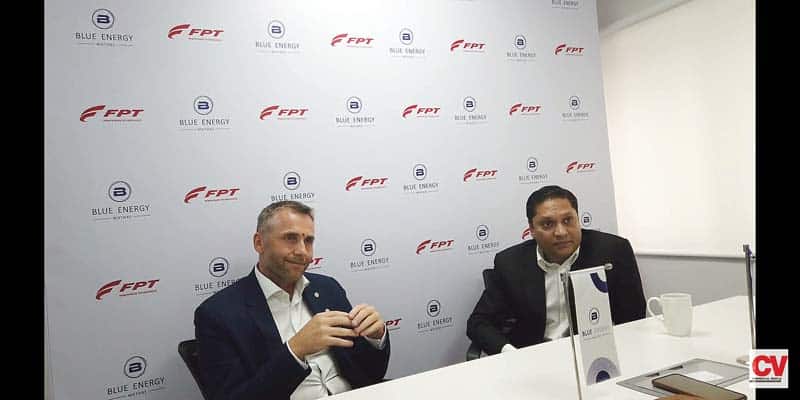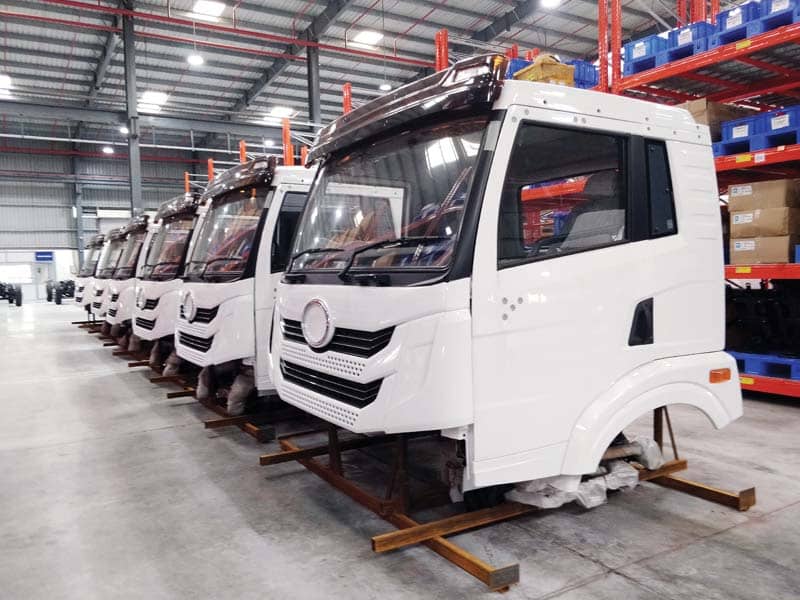Anirudh Bhuwalka, Chief Executive Officer at Blue Energy Motors and Sylvain Blaise, President of the IVECO Group, Powertrain Business speak to Prateek Pardeshi on the joint, grand and green plans for India.
Q. How was the experience in shaping up the maiden product at BEM?
Anirudh: Well it’s India’s first LNG truck, so we are all excited. It has been a pioneering journey for us, because, as you know, there are no or few LNG trucks. It’s a new technology. We believe that India is ready for it. It has taken us two years to get to this stage. We have collaborated on this project and worked on this project. It’s a milestone.
Q. How is FPT Industrial linked to BEM?
Sylvain: We at FPT are a global power train company. So we design, build and sample different solutions globally. For us, it’s a great opportunity, because we’ve been historically present in the Indian market with customers like CNH Industrial, but this is our first application in the Indian market on a truck application. I mean, of course, we are leveraging on 25 years of experience in natural gas technology. Moreover, we have been pioneering this type of technology in Europe where we built a market-leading position there, and we are leveraging this here now. Now to the adaptation we’ve done over the last 18 months, it’s a specific development to suit the needs of Indian market.
Q. What made both the OEMs select the six-litre NG engine from the broad FPT range?
Anirudh: I think India is very low on the power-to-weight ratio. Historically, unlike in Europe and North America, and even for that matter China, they have all graduated to more powerful engines, India is still moving from low power to higher power engines. So until a decade ago, we were at 180 horsepower for a heavy-duty truck. But in India, it’s also unique because the speed at which we run our trucks is less than 35 kilometres per hour and the distances that we cover on an average is about 350 kilometres with the heaviest duty truck on a single day and no more. So, our duty cycle requirements are lower in terms of what the truck needs, but having said that, the other issue which comes as a capital cost in India, the logistics cost right now is undergoing its own share of challenges. If we increase the capital costs of the truck, then the operating costs fall. If we were to marry all these, you need the 6.7-litre, 280 horsepower engine with 1000 Nm torque on offer by us.
Q. Can we run the engine on alternative fuels?
Anirudh: Yes, this is a gas engine and can be run on CNG, LNG and biomethane.
Sylvain: In terms of performance we did what we like to believe, delivers a performance close to the performance of a diesel engine.
Q. How are you ensuring ready availability of spare parts?
Anirudh: We are basically developing the complete spare parts requirements ecosystem. We are just starting out and so still gauging the requirements as we go along. However, I can tell you that we are going to have a joint programme of stocking spare parts both in India and in Italy and throughout our service network to cater to the demand.
Q. What is the localisation degree?
Anirudh: The engines are completely sourced from Italy right now. The rest of the truck is, of course, made and assembled in India. The engine comes as a fully built unit. Right now, barring the engine and a few other components the truck is localised out of India. The cabin comes from China. The out sourced components and parts constitutes a very small percentage of the overall truck, with the power train, axles, the gearbox and the chassis from India. Incidentally, out of the 122 suppliers, we have 100 in Pune itself. It’s a complete design engineered and built for the Indian market.
Sylvain: The industrial setup here benefits from a full ecosystem around the automotive and truck industry. It allowed for a quick setup. Obviously, before we speak about the full localisation of the engine, we need to closely watch the maturity of the market and the volume we build up over time.
Q. How was the testing phase?
Anirudh: There are two parts to it on the engine side. FPT did what they do best because they have been an engine manufacturer for decades. So they know, what a world-class engine is, and on the truck side, we developed the product over the last two years through rigorous testing and a high degree of collaboration.. We’ve been working together on this project for almost two years now. So there’s a lot of integration between the two teams between both Italy and India that has made this truck possible.
Q. Since BEM is a startup, is it bootstrapped?
Anirudh: The basic idea of this startup is to be a zero-emission commercial vehicles company. We are fully funded as of now. Right now, our target is to launch the LNG truck that we are coming out with, keeping in line with our vision to be a zero-emission company. The second product that we will see soon, perhaps as early as next year would be the electric version of it. Our target is going to be to disrupt the trucking industry on the product side. We are fully funded and maybe towards the end of the year or next year depending on how we scale up we will see if we need to raise more.
Q. What are the shop floor efficiencies and state-of-the-art capabilities?
Anirudh: Truck assembly historically is a low automation mode, because they are, very heavy. In terms of automation levels. It’s fairly not required when it comes to the truck industry. Having said that, all the testing of the trucks which have been done during development, is automated as this cannot be done manually. So it has been conducted across nodal agencies and centres like the ARAI and NATRAX where they have advanced facilities. Today, we have an unique opportunity where we can leverage capabilities all around us, rather than investing under our own hood and Pune gives us that opportunity.
Q. In the future are you expected to opt for the PLI scheme?
Anirudh: No, we are not applying in the PLI scheme. Our business model is that we are an engineering design technology driven company.We do last mile integration, distribution, service, support, financing, and have a subscription-oriented model. This is what our core business model is. So we are going to be focused on the core of our business and we do not intend to get into value-added manufacturing.
Q. Are there any more technical collaborations or IP licensing for the truck?
Anirudh: Yes, we do, we would like to share the details in the coming future.
Q. How would you compare an LNG truck with CNG on the basis of TCO?
Anirudh: So, the fundamental of CNG versus LNG is that in case of CNG you cannot use it for the long haul because CNG has a limitation on how much gas the tanks can carry. CNG is very good for three-wheelers, and four-wheelers commercial vehicles because they have a range of zero to 200-250 kms. But if you want to do long-haul trucking, which is beyond 400-500 kms, LNG is the only way to go. Fundamentally when it comes to gas there is not much difference per say from a technology standpoint, but the game changes once you use LNG on a heavy-duty truck and a heavy-duty truck starts becoming a viable alternative.
Q. Why is it disruptive for the Indian market?
Anirudh: I personally believe that India imitates China when it comes to growth. China launched LNG trucks for the first time in 2015-16. They sold 15,000 trucks for the first year, but the market was much larger. By the second year, they sold 75,000 trucks. Today they are selling 150,000 trucks representing 14 per cent of the market. And this is also only because the LNG is available around the coastline, not so much inland. If you use that as an example, in India, we believe the operating economics of LNG are superior to that of China. So depending upon the proliferation of the LNG network, we expect 1,000 outlets to come up over the next five years. My anticipation is that LNG trucks are going to take up a significant market share in the years to come.
Q. Can you highlight the testing undertaken on 5528? Tell us about the aftersales warranty and services?
Anirudh: We’ve been doing it for two years. We’ve clocked in excess of 1100,000 kms for all trucks put together. We are just freezing the warranty aspect this year. Now the product is ready. So we’re just going to crystallise the ecosystem desired.
Q. In hindsight what do you make of this collaboration in India for long-haul trucking?
Sylvain: Basically we started 18 months ago with this project to now, a product we’ve launched. It is remarkable the way we’ve been working together because I think it is the true spirit of how we work. The strategy has been to build on the respective technical expertise, innovation, agility as one entity.
Anirudh: When we started the project during Covid-19 as a startup, it was all about pioneering LNG on a heavy-duty truck in India. FPT had to bet on us to develop and invest in LNG technology suitable for India when they had no other project. We had to bet on partnering with FPT for this technology and depend upon them for the collaboration. So I think that it’s kind of surreal that we have reached here.





















